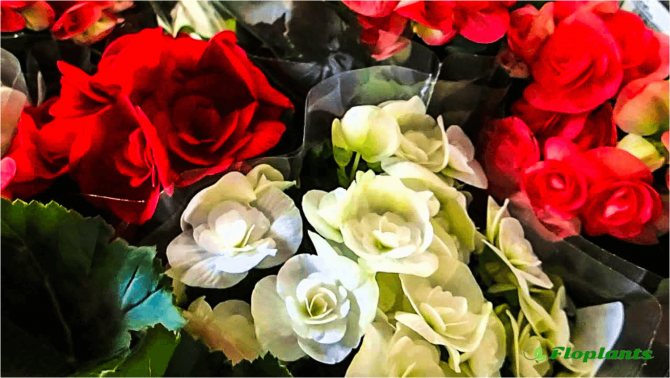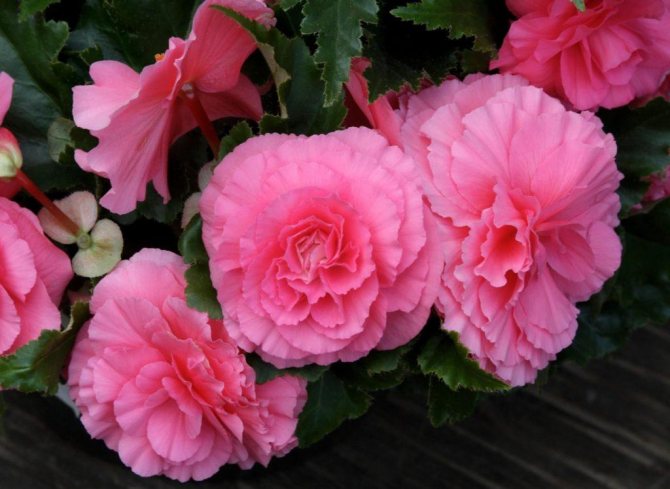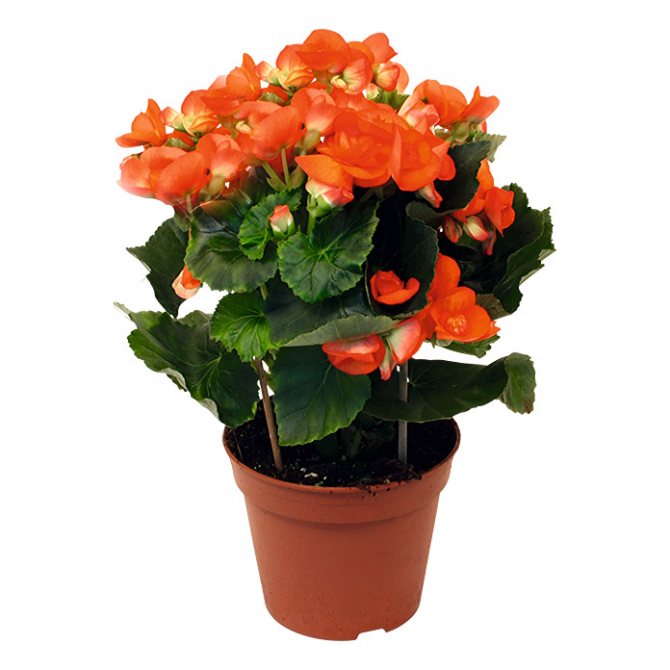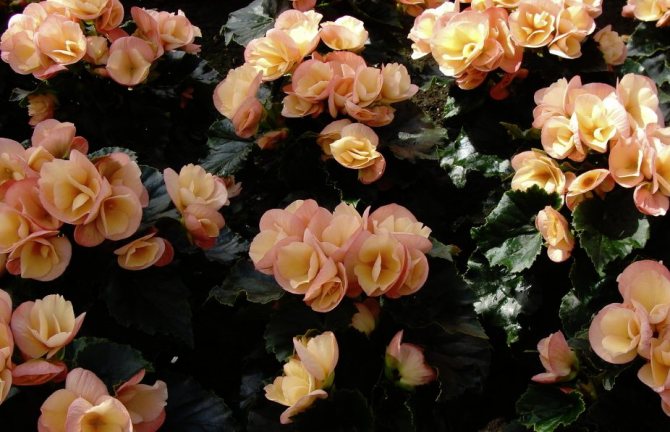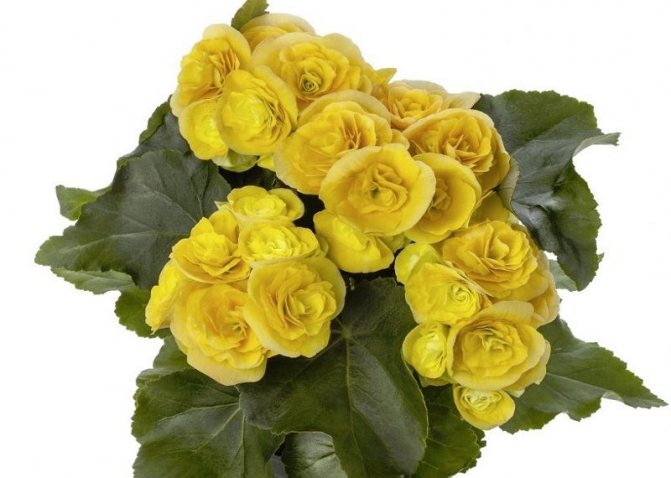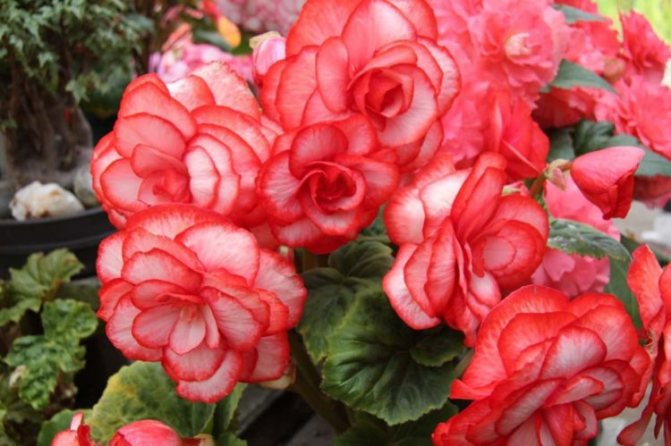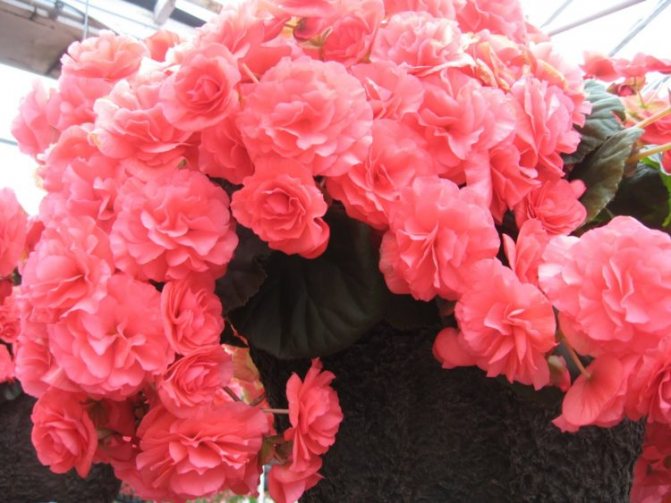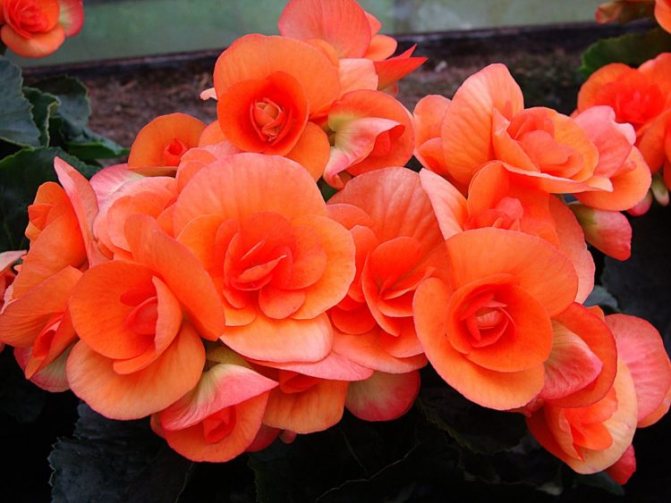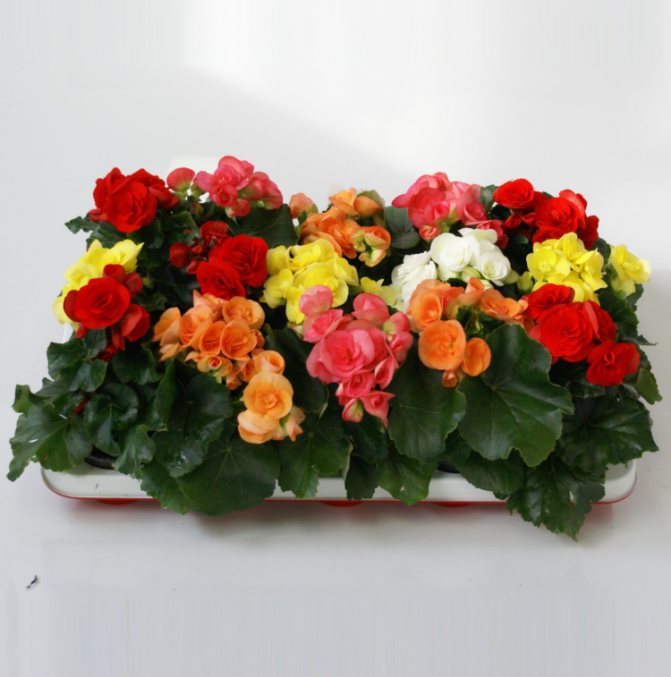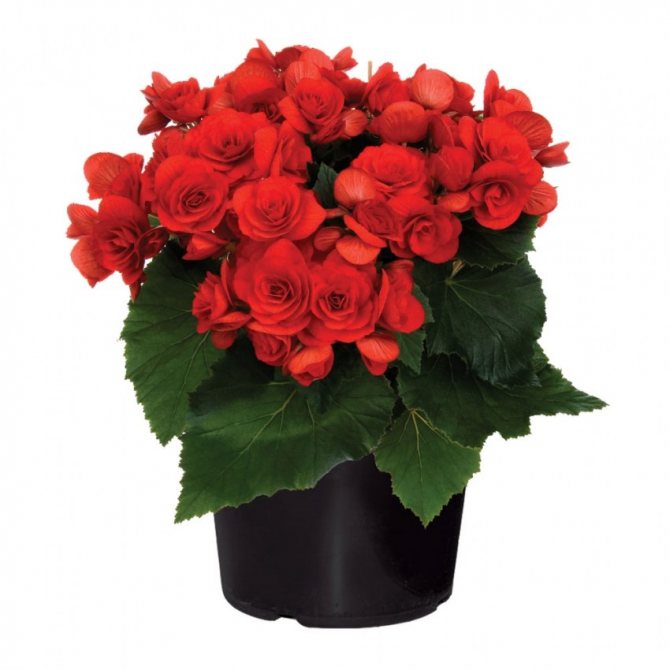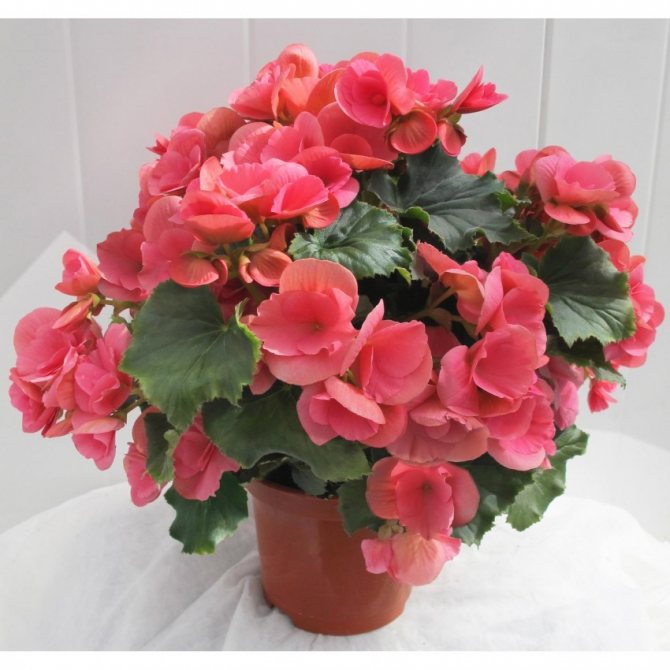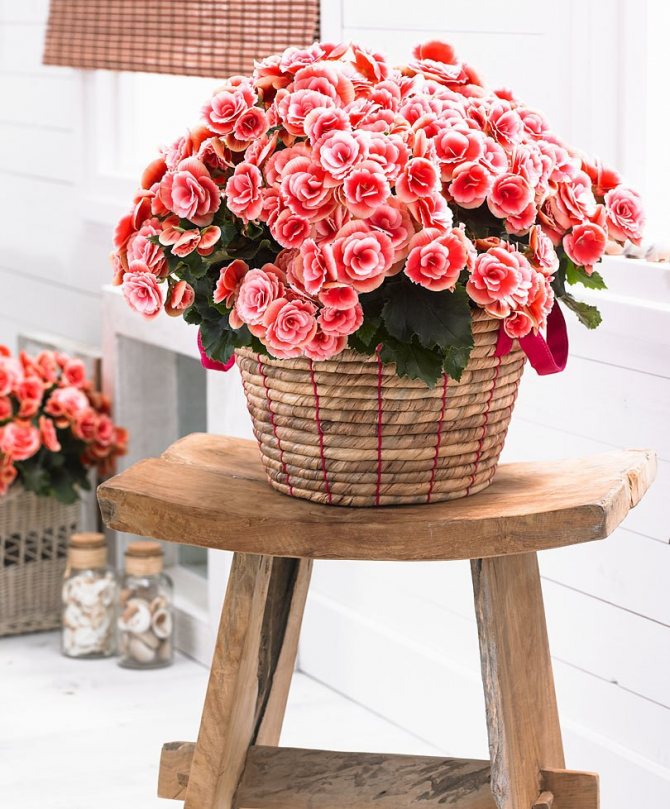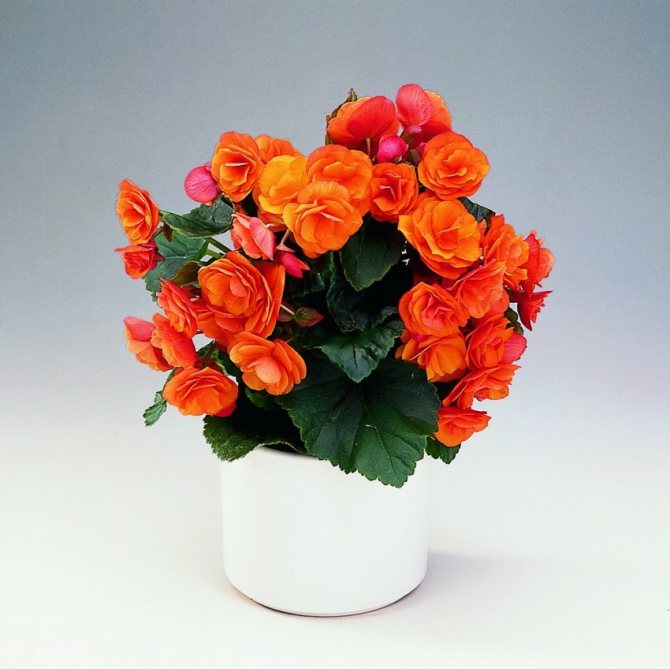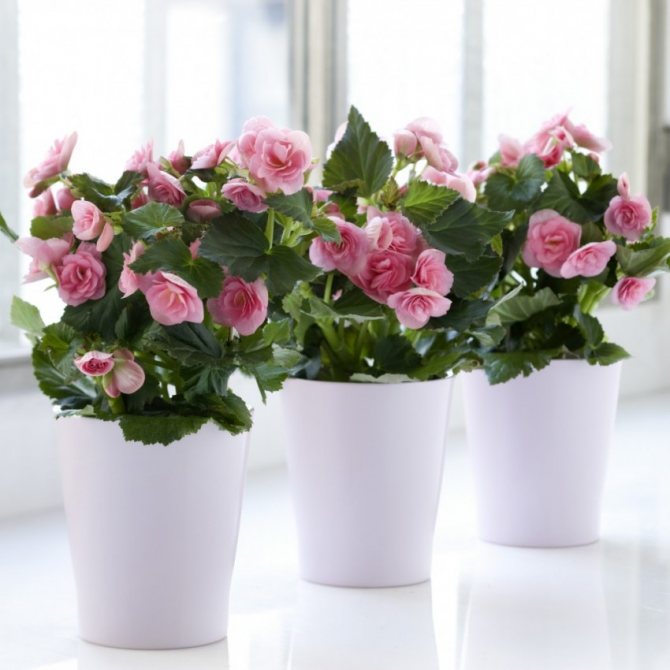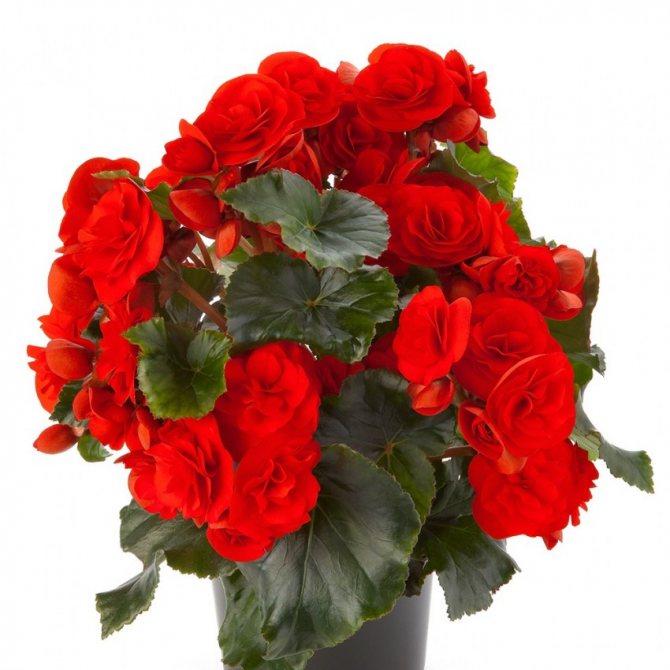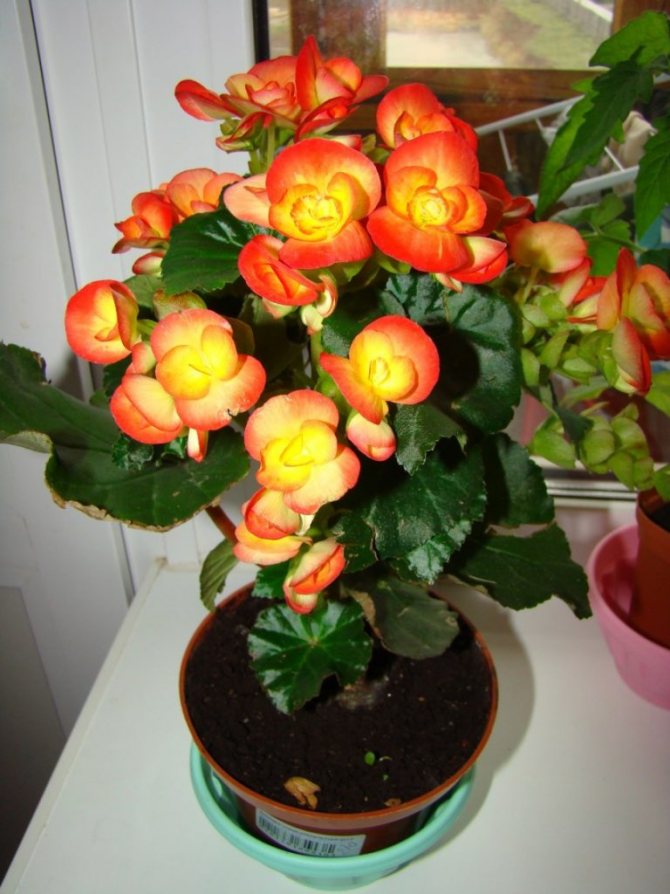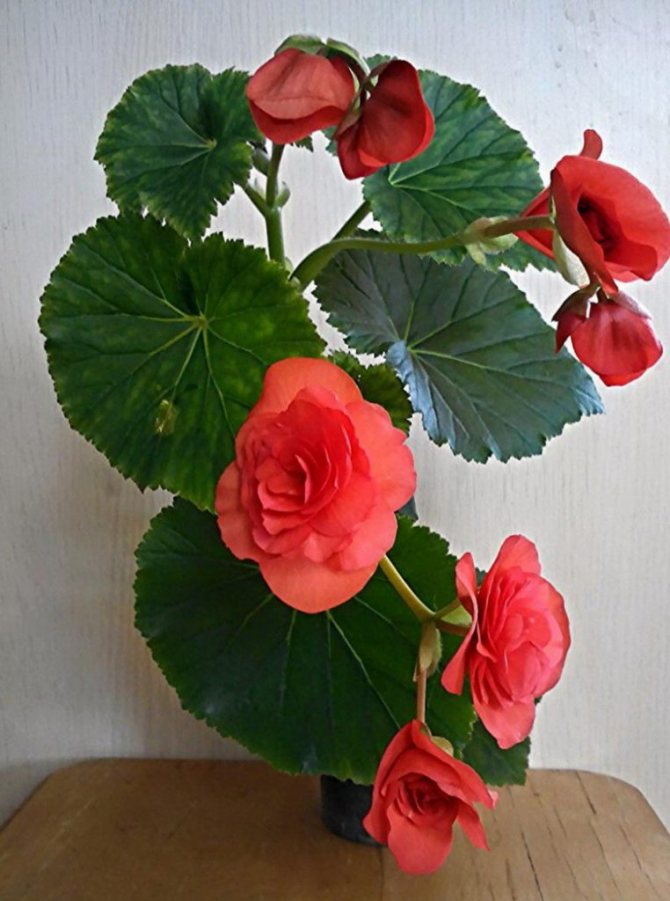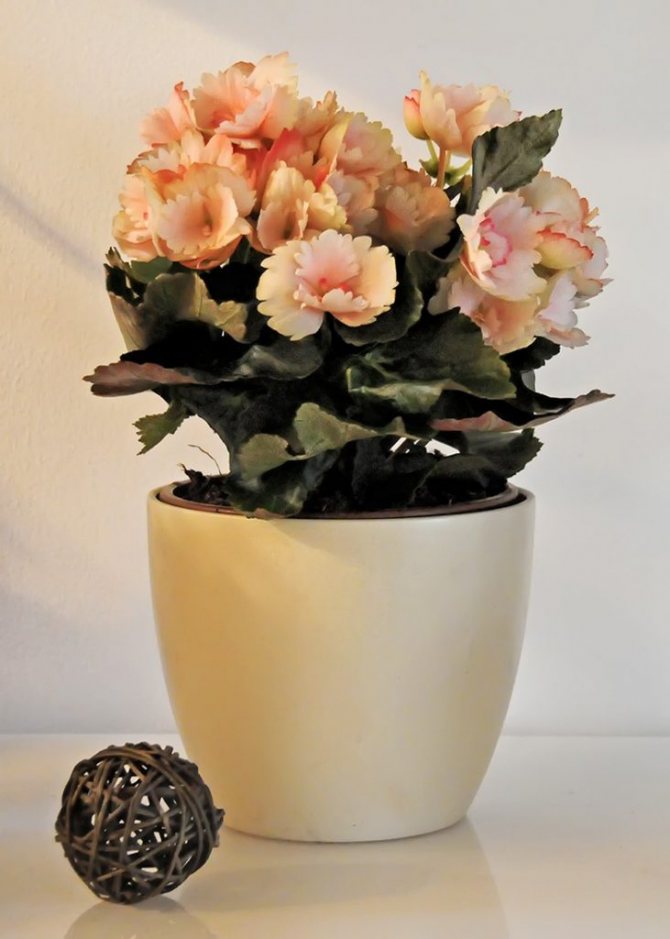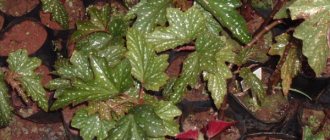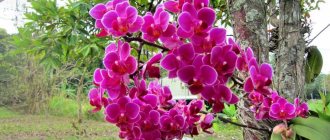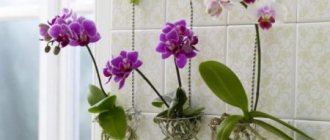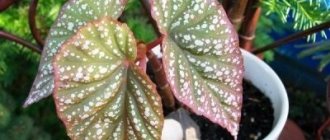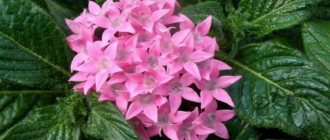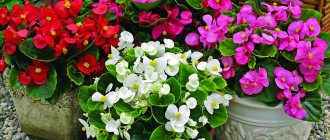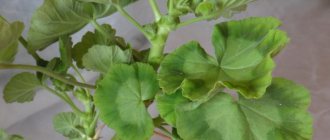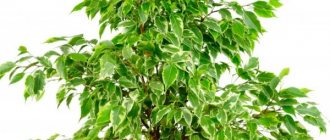Elatior hybrid begonia is one of the most charming representatives of begonias. Differs in fast growth, bright and juicy flowering. Flowers are medium-sized, but abundant, lush, beautiful shades - an excellent pot culture. It is also called winter, because it is able to delight with flowers in the cold season.
Scientific name - Begonia hybrida elatior (sometimes you can find synonyms: Winter begonia - Begonia hiemalis). Parents: Begonia tuberhybrida and Begonia socotrana. You can see them below in the photo:
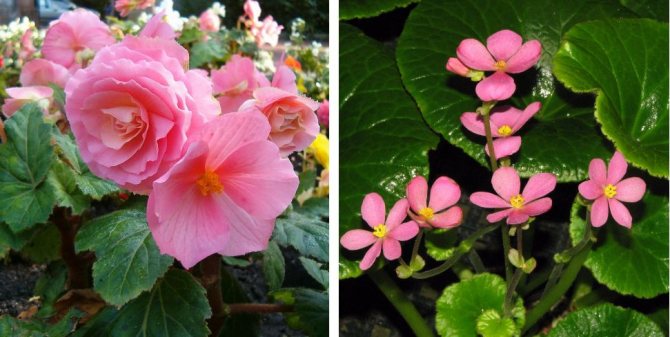
Tuberous begonia and Socotranskaya begonia.
Description
Compact herbaceous plant, short, maximum 40 cm, perennial, often grown as an annual. It can be both a houseplant and an open field culture. Shiny juicy foliage, fleshy stems, medium-sized flowers, 3-5 cm, can be either non-double or double. Most often there are forms with semi-double flowers. The colors are bright, neon, or two-tone. A range of shades: white, pink, yellow, orange and red. All hybrids are divided into three growth groups:
- Stunted.
- Medium-sized.
- Tall.
As a rule, Elatior begonia is grown for one season, by the next year the plant loses its decorative effect (grows over). On sale, the plant can be found very often, so it is a grateful culture adapted to the conditions of the premises, it is sold all year round. It is often confused with ever-flowering (always-flowering) begonia, and even in stores on sale you can find the ever-flowering begonia Elatior, however, botanically these plants have different Latin names (always-flowering begonia - Begonia Semperflorens).
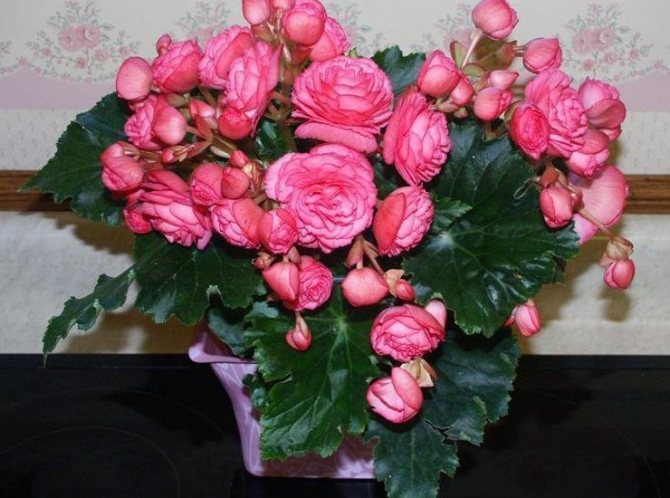

Flower features
During the selection period, Elation begonia became widespread - it is grown more often than other begonias and bought as a gift.
Fame, however, has led to a number of misconceptions even by experienced gardeners - for example, this species is often considered tuberous, although in fact the flower is a hybrid of Socotran and tuberous begonias. However, this is not surprising - the result of crossing was amazing.
The flowering bush grows on average up to 40 centimeters, is distinguished by juicy fleshy stems and glossy dense carved leaves with jagged edges of a characteristic color (top - juicy green, underside pale green). During flowering, the plant is covered with bright inflorescences of rich juicy shades on thin peduncles growing from the leaf axils.
Growing conditions
In general, the plant is unpretentious, but certain conditions must be observed. If the conditions of agricultural technology are not observed, it begins to show "character" - that is why the opinion on the forums that this is a capricious culture. However, it is worth getting used to, as it turns out that, in fact, the agrotechnology of the Elatior begonia is one of the most uncomplicated.
Shine: abundant diffused light, western and eastern windows. Does not tolerate direct sunlight - too bright sun causes burns to the leaves and crushing of flowers. The plant does not need illumination, the plant blooms even with a short daylight hours.
Temperature: This is a typical begonia that needs moisture and warmth, the optimum temperature is 20-25 ℃, the lower limit is 18 ℃. If the room is cooler, the buds fall off, and the plant itself begins to ache.Begonia should be protected from drafts.
Humidity: The plant loves air humidity, but it is better that moisture does not get on the flowers and leaves. It is optimal to have a humidifier at home, and put the plant itself on a bowl filled with moist moss.
Soil and pot: begonias need loose, water- and air-permeable soil (a mixture of peat soil, humus, sand). The pot should be compact. The root system is fragile. Transplants are undesirable. After the purchase, it is better not to transplant the plant, but to take the cuttings for rooting.
Attention: do not rearrange the blooming Elatior begonia from place to place. From this, the buds of the plants fall off.
Watering: moderate, as the earth lump dries up to half. Overflow easily leads to root rot.
Top dressing: practically unnecessary. Several times a season, you can feed the plant with a complex mineral fertilizer. Organic fertilizers affect the plant negatively.
Transplant features
One of the important rules for elatior begonias when caring for home is the correct transplantation of a purchased or donated flower to a permanent residence.
The first thing to remember is that this begonia hybrid does not like large pots - the root system develops poorly and does not have time to cover a large amount of land. Therefore, each subsequent pot should be only a couple of centimeters larger than the previous one.
The soil for transplanting should be selected loose, retaining moisture well, but also drying quickly if necessary. For self-production of soil, you should take in the same parts:
- peat land,
- greenhouse and leaf humus,
- add calcined sand
If the plant has spent too long on store shelves and managed to grow, it is not worth replanting - it will be enough to cut and root the cuttings for subsequent planting.
Other important points of care
In Elatior begonia, shoots can be ugly stretched out, especially with a short daylight hours, so the plant is pinched several times to form a compact, neat bush.
They are fed 3-4 times per season: potash fertilizer at weekly intervals almost immediately after planting (for a set of green mass), then complex fertilizer for flowering plants.
When cold weather sets in, plants from open ground can be transplanted into a pot and stored in the room.
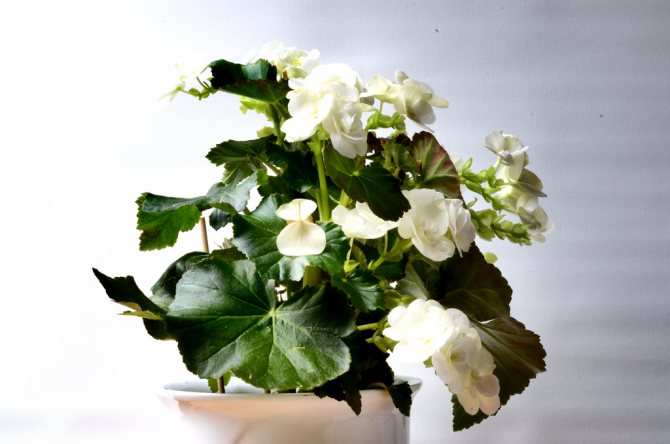

Breeding features
Begonia reproduces in three ways:
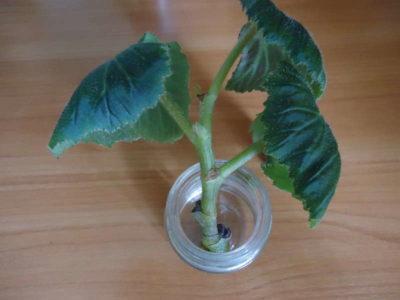

Cuttings are cut from a faded plant, and then placed in wet vermiculite or perlite. Sphagnum moss is also suitable for rooting, which additionally has a bactericidal effect. Can also be placed in a glass of water and an activated charcoal tablet. So the cutting will give a root faster. In this case, the shoot should be at least 7 centimeters long. This is the most common type of flower reproduction.- The seeds can be sown all year round. In a period with poor light, you need to provide them with additional lighting for germination. However, this is a painstaking, less frequently used method.
- You can simply divide the mother bush by planting it in different pots. But in this case, do not forget about the fragility of the roots, so this process must be delicate. For this reason, it is also rarely used.
It is best to grow begonia from a cuttings. It is faster and more reliable. But in this case, it is important not to forget about regular pinching for the splendor of the bush. Read more about the propagation of Elatior begonias by seeds and cuttings here, and you will learn about the features and nuances of these types of reproduction in this article.
Reproduction
Begonia Elatior reproduces well:
- Seeds - a laborious process for home conditions. It will take at least a year to grow plants, and all this time you will have to carefully monitor the humidity, temperature and light.
- Apical cuttings - the favorite way of flower growers.Begonia Elatior propagates very easily by cuttings. It is enough to cut the stems from 7 cm long and put them in water, moss, vermiculite. After 1-2 months, roots begin to grow.
- Leafy cuttings. The veins of the leaf plate are cut and placed with cuts on moistened moss, sawdust. After a month, roots and small plants will appear in the area of the incisions.
Reproduction methods
Like other types of begonias, in Elatior reproduction can occur in two main ways:
- seeds;
- by cuttings.
It is unlikely that it will be possible to independently collect seeds from a pet, since the elatior is a hybrid. Purchased seeds require a lot of attention and care. This is a very painstaking method, with the slightest violation of agricultural technology, you can destroy all the seedlings.
A much more convenient and simple way to propagate your favorite begonia is to cut cuttings from it. It can be both leafy and stem cuttings (at least 7 cm long). You can root them in different ways:
- in wet sphagnum;
- in perlite or vermiculite;
- in water with the addition of activated or charcoal.
Cuttings planted in suitable soil are placed in a dark place and checked regularly, watering if necessary.
Two months later, when new leaves begin to appear in the cuttings, young plants are transferred to a permanent, well-lit place.
One of the elements of caring for young begonias is pinching. This helps to form a beautiful bush, as well as remove wilted flowers and leaves in a timely manner.
Types and varieties
The Elatior class of begonias was created more than a century ago, in 1883 in London. It is not surprising that by today a lot of plant varieties have appeared. Breeders managed to achieve not only a variety of forms and colors of culture, but also excellent technical characteristics. The plant is resistant to fungal diseases and rarely causes trouble even for amateurs.
We will describe only some varieties, it is unrealistic to cover all the variety. In addition, the availability of varieties on sale from region to region can vary greatly and for some the varieties described below will be rare, for others - on the contrary.
- Annebell - semi-double yellow flowers. An open field plant.
- Azotus - double pink flowers. Indoor plant.
- Baladin
- a well-known variety Baladin. Compact (up to 25 cm), semi-double flowers, bright red. - Balamon
- juicy double orange-red. - Barkos - double, bright, red flowers.
- Batik
- semi-double and simple juicy orange-orange flowers. - Bellona - flowers are red, double, large.
- Berseba
and
Berseba red
- Densely double pink and red flowers, so abundant that foliage is not visible. - Berlin - light pink, lush, double flowers. Used as a pot plant.
- Binos
- this is a variety series with textured, double, dense flowers, collected in powerful brushes. Colors: Binos - coral, Pink - dark pink, Binos Soft Pink - delicate pink-peach with a yellowish center. - F1 Charisma - this is a variety series of low hybrids up to 25 cm with double and very large flowers (5 cm), blooms for a very long time and abundantly. Shades: Lachsorange - dark salmon, Rosa - flowers are dark pink, Scharlach - flowers are orange-red, Tiefrose- dark pink.
- Blitz
- bright yellow semi-double flowers. - Bonbon white
- flowers are simple and semi-double, white with greenish shadows. - Borias.
Begonia Elatior Borias are compact plants with simple and double pink flowers with white edging. Flowering is very long, and the plant itself pleases with the freshness of colors and gloss of foliage. - Britt dark
- simple hot orange flowers. - Camilla
- very delicate semi-smeared white-pink flowers, with a red edging along the edge and yellow-green central petals. - Carneval
- contrasting cheerful colors, the central petals are yellow with an orange tint, the outer ones are orange-red. - Catrin
- small two-tone orange-reddish flowers, beautiful contrast with dark green foliage. The plant is sprawling, lush. - Ceveca
- an unusual form of semi-double coral pink flowers. The petals are strongly elongated, palmate, pronounced, the flowers are very large. - Cindy Franje
- apple-pink flowers with a greenish center and a thin red edging, an unusual serrated edge of the petals. - Clara
- simple and semi-double white flowers. The buds are greenish, which adds charm. - Cottage Collection
- a series of ampelous forms, with especially long peduncles, which end in clusters of medium-sized semi-double flowers. Shades:
Bright Red -
juicy red color,
Double pink
- bright pink color "barbie",
Salmon
- salmon,
Vintage Pink
- delicate pink with a slightly beige undertone. - Cottage Vintage Pink
Is a more compact form than the plants from the Cottage Collection. The flowers are simple, pinkish-beige, a sophisticated shade reminiscent of the tone of an old postcard. - Cleo - salmon flowers, semi-double, medium-sized, abundant flowering.
- Dragone champagne
- dense, apple flowers. - Dragone
- Abundant, densely double, bright pink flowers with a cap. - Eva
- very bright and abundant yellow flowers. - Goldfinger - light creamy yellow flowers, double. Potted plant.
- Glory pink
- large semi-double pink flowers, very dark foliage.
Glory white
- has flowers of a beautiful shape, as if carved from porcelain, white with a slightly yellowish center. - Janny Franje
and
Kristy franje
- these are two varieties with multitonal flowers of complex colors, with a slightly jagged edge of the petals.
Janny
- pale orange and apple green tones.
Kristy
- the most delicate pink and greenish shades. Very refined varieties. - Kyoto - cbranches are white, large, densely double.
- Lax
- very large, semi-double, orange-pink flowers on dark green foliage. - Louis - light cream with pink flowers.
- Nadine
- bright yellow semi-double flowers. - Nelly -
similar to Kristy Franje, only without such pronounced apple-green shadows. - Netja dark
- Abundant, hot pink flowers with a cap. - Peggy
- unusual luminous colors. Luscious pink flowers with a white glow from the center. - Piccora - flowers are large, double, bright pink. Feels great outdoors.
- Red baron dark
- very dense, double, bright red flowers. - Red Improved
- Terry, dark red flowers. - Renaissance... The plants are tall, the flowers are red, densely doubled, corrugated, ornamental cut leaves. Indoor plant, grows poorly outdoors.
- Sandrine
- coral-pink hot flowers, in the buds - apple-green. - Solenia series
- very large, double flowers resembling tuberous begonias.
Colors: Dark Pink
- dark pink,
Light pink
- light pink,
Light Yellow -
lemon yellow
Orange
- Orange,
Red orange
- red-orange,
Soft pink
- silky light pink flowers. - Sweet dreams
- candy pink flowers with unusual elongated petals. - Schwabenland - cbranches are bright red, non-double, small, very abundant flowering.
- Veronica
- Abundant, clear, like a chiseled shape, double red flowers. - Yellow stone
- Densely double, sunny yellow flowers.
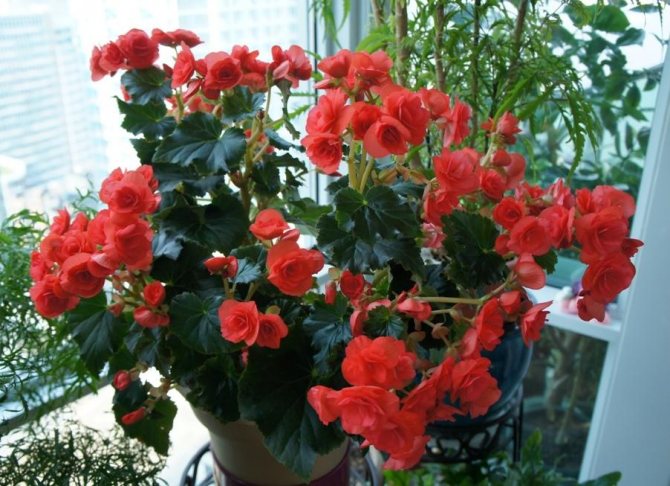

Dragone Rosewood
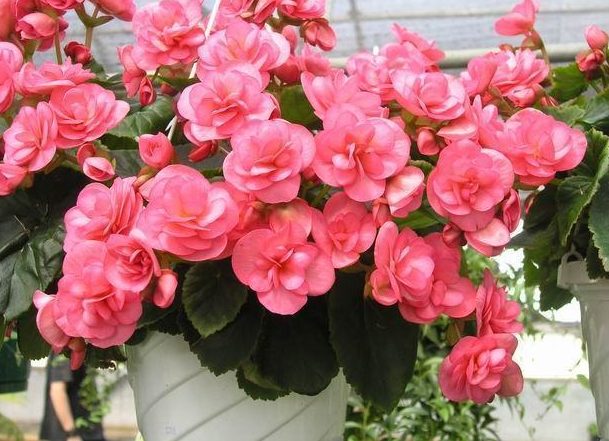

Barbara variety
Care rules
In order for the plant to delight with the freshness of the leaves and long flowering, one should carefully consider its needs, providing:
- temperature regime - without lowering the heat below 18-20 degrees - this is an extreme threshold for the survival of a flower, at other temperatures leaves and peduncles will irreversibly suffer;
- correct watering - often the flower is watered only during the period of active growth, and already during flowering, the amount of water is reduced by three times (the plant itself will report a lack of moisture - lowering the peduncles);
- spraying prohibition - no matter how much you want to return the brightness to the flower during the rest period, water droplets on the leaves will damage them;
- pruning - in perennial bushes, cuttings should be cut every spring, leaving no more than 8-10 centimeters;
- removal of dead buds that pull the strength of the plant, preventing the emergence of new flowers;
- alternate feeding with stimulants and immunomodulators (for example, "Epin", "Zircon");
- use of fertilizers - any mineral fertilizers are suitable for begonias, while organic fertilizers are better not to use because of the abundance of nitrogen, which worsens the structure of cuttings and stems (they become watery, weak, fragile, lethargic, and the flowering will be weak).
Difficulties and problems
Judging by the reviews, they are not uncommon:
- Begonia is losing leaves. Most likely, the plant lacks moisture. Both in the pot and in the air.
- Pale leaves, elongated stems, weak flowering - lack of light.
- Dark spots on stems and leaves. Probably a fungal disease. Remove all affected parts of the plant, treat with fungicides.
- Twisted leaves, dots, spots, depressed growth - spider mite (begonias are also often affected by aphids). To get rid of them, either a purchased insecticide or a soap solution is used.
- White bloom on stems or leaves - powdery mildew. Prevention of its appearance: no temperature extremes and sufficient air humidity. The plant is treated with fungicides or sulfur.
Plant diseases
Begonia has several painful conditions caused by simple reasons:
- low humidity and lack of watering - the plant sheds leaves;
- high humidity combined with cold - the appearance of rot and mold on the leaves;
- lack of lighting - pallor and weakness of the leaves;
- the plant is also susceptible to powdery mildew, aphids and spider mites.
Proper care of a hybrid of begonia will help to avoid any diseases, and a luxurious scattering of flowers will delight the eye for many years.
Testimonials
Apparently, the Elatior begonia is very popular with flower growers. Spectacular culture. Bright, juicy and odorless (plus for allergy sufferers). An excellent pot and balcony culture that requires minimal maintenance, but is so decorative that one can make a balcony stand out. Opinions differ greatly about unpretentiousness: some consider it completely unpretentious, others call it a capricious plant, but do not give up trying to make friends with her.
Particularly successful growers manage to extend the flowering of an old plant up to two years, pruning the bush in time (and using cuttings to get new plants). Some note that their plants bloom even in a draft or on the north window, and do not require maintenance at all, while still covered with flowers. Of the problems they describe: the rapid death of the plant, the fall of flowers immediately after purchase, problems with reproduction by a leaf or cuttings.
Varieties of plants and photo varieties
The hybrid is divided into several types depending on the height: undersized (up to 25 cm), medium-sized (up to 30 cm) and tall (up to 40 cm). Let's consider the most popular types.
Borias
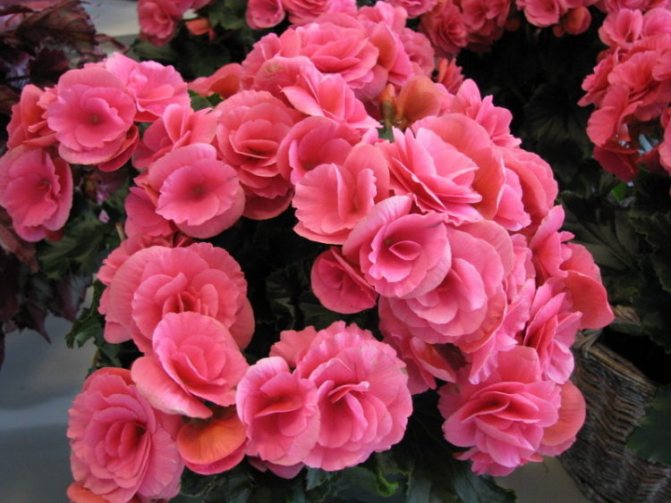

Hybrid of English origin. She is rather medium-sized, because she is so compact. The flowers are double, pink with a graceful white edging. Differs in unpretentious care.
Mix


Hybrid variety of medium bush height. The flowers are mostly double, in different shades. It is this species that is more often available in gardening stores. Begonia Mix is distinguished by long flowering and easy care.
Advice: Begonia elatior is great for a gift instead of a bouquet.
Question answer
When to transplant Elatior begonia after purchase?
Dutch begonias are sold in stores, these flowers, of course, are not adapted to indoor conditions. Immediately after purchase, inspect the plant, remove damaged leaves, water, if the soil is too dry, you can wash the plant in an epin solution. Place in a suitable (well-lit, but not in direct sunlight) location. After 2-3 weeks, begonia will begin to give fresh sprouts, already accustomed to your conditions. Now you can transplant her, she will tolerate the transplant well.
I bought Elatior begonia and immediately transplanted it, some of the buds have disappeared, is it worth worrying about the further well-being of the plant?
Everything is fine, when you change the place, the loss of flowers is natural for any indoor culture. If the begonia is now developing well and producing new buds, there is nothing to worry about, provide it with standard care.
How to take care of it properly?
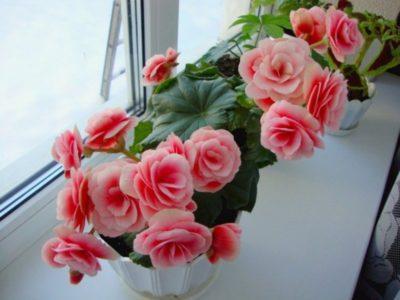

The bush loves moderate watering, the frequency depends on the flowering period - during it it is more abundant, then cut by three times. Watering should be done when the soil is almost dry.In no case should it be sprayed! After all, this leads to the development of various fungal diseases, and can also act as a magnifying glass in the sun, leading to leaf burns.- Prefers a temperature not lower than 18-20 degrees. At a lower level, it dies. It does not tolerate frost categorically. Room temperature (25 degrees) is acceptable.
- It is important to remove faded flowers in time. This preserves the splendor and makes room for new buds.
- Extremely susceptible to stressful situations and deteriorating conditions of detention.
- During the dormant period, when flowering is finished, special care is required. After the so-called wintering, cuttings are trimmed to 7-8 centimeters. The above-described irrigation regime and temperature regime are observed. It is also recommended to use growth stimulants like "Epin", "Zircon". They will help to avoid a variety of plant problems.
Other types of begonias also require special care. In order for them to bloom and delight you all year round, you must adhere to certain rules. We talked about this in the following articles:
- Interesting information about flowering begonia.
- Basic rules for caring for ever-flowering begonia at home.
- Magnificent terry ever-flowering begonia.
We recommend watching a video about Elatior begonia care:
Resting care
Correct wintering for all plants - the key to active growth and flowering in the warm season. The main thing that you need to pay attention to is the temperature of the content and the watering regime.
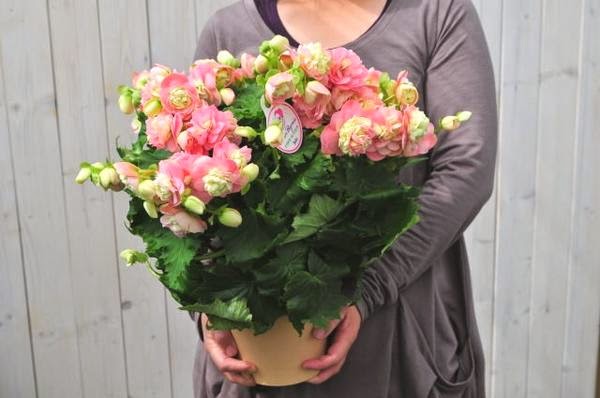

The temperature must be kept between 18 - 20 ° C, when the temperature drops, begonia will get frostbite and die. Sudden temperature changes are contraindicated. Cut watering by half, stop spraying.
Additional lighting in winter is not required, enough daylight hours.
Features of begonia eliator


Begonia is a perennial ornamental plant. In nature, it is found in the highlands of tropical hot forests. This plant has a characteristic feature - this is a pronounced asymmetry of the leaf plates. The flowers of this plant are distinguished by their splendor and high decorativeness. This plant is cultivated both indoors and in the garden.
The genus got its name in honor of its discoverer - Begon. In natural conditions, this plant was found in South America, India and Africa. Begonia was first discovered and described in the Antilles. At the moment, there are only 6 species of this plant, however, thanks to the efforts of breeders, more than one thousand different varieties have already appeared. But among all this variety, there are no tall and medium-sized varieties. The bushes are quite low, and therefore they are most often used to decorate rooms. This ornamental plant is often used as a climbing culture. Begonia eliator is a spectacular bush with lush flowers. This is what explains the high popularity of this plant.
Scientists have found that such a flower is able to cleanse the air from pathogenic microbes. It secretes phytoncides that fight staphylococcus most effectively. It is because of this that you can increasingly meet begonia in kindergartens and medical institutions.
The most vigorous varieties of this plant reach a height of 25 to 37 centimeters. Medium-sized varieties include those whose height varies from 15 to 18 centimeters. Low-growing bushes are only 8-15 centimeters high. Breeders managed to breed varieties:
- with a shrub structure;
- with upright shoots;
- with climbing stems.
Even a variety has been bred that is capable of blooming all year round, but in mid-latitudes it cannot be cultivated in open ground. Such a plant needs warmth throughout the year.
Begonia is divided into three main categories:


- bush - has no pronounced specificity;
- deciduous-ornamental - leaf plates are medium or large, and they are decorated with wide stripes;
- tuberous - in this group, representatives differ from each other only in flowers and shoots.
Interestingly, this plant is capable of forming a different root system. And what kind of root system the bush will have depends on the growing conditions. For example, when growing begonias outdoors, tubers are formed. A bush growing indoors has fibrous or rhizome roots. In those specimens in which tubers are formed, the most powerful and tall shoots grow. And flowers with a fibrous or rhizome root system are ideal for planting in decorative baskets.
Flower care at home
When growing Begonia Elatior, you need to take into account a lot of factors, thanks to which it will grow beautiful and will delight your eyes. For this you need to know:
- how to water;
- what kind of humidity, temperature and lighting she needs;
- what kind of soil and fertilizer are used.
And also you need to choose the right pot for her, pin the plant at the right time and prevent its death due to pestswho love to profit from Begonia Elatior.
Now let's take a look at all these points in order.
How to properly water the plant
As for watering, here you need to be extremely careful with this flowersince he does not like a lot of moisture.
In winter, it is easier to decide on watering when Begonia is already an adult flower, since its young shoots can wilt a little if they do not have enough water. But a young plant is not worth risking. It is necessary, when the soil dries out, pour it with a little water.... This will be enough to keep the flower alive.
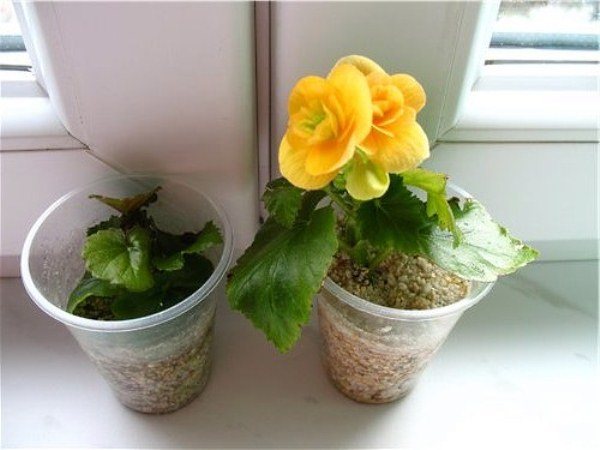

In summer, the flower responds well to spraying on the leaf mass, but keep in mind that it should be carried out only in the evening.
In summer, Begonia Elatior loves spraying. Only with him you need to be extremely careful and do not forget that even thanks to a small droplet, if the sun's rays hit the plant, they can leave burns on it.
And here in winter, it is completely forbidden to spray a flower, since excessive moisture, can provoke the appearance of fungus and rotting of the plant.
Optimal temperature and lighting
You should also know that Begonia Elatior is a very sensitive plant, for which in summer it will be necessary to ensure the temperature in the range of 20 to 25 degrees... And in winter, the main thing is not to allow constant sudden changes in temperature. In addition, the temperature regime during this period should not fall below 18 degrees.
The flower loves good lighting, therefore it is better to place it on the windowsill or in front of it so that the flower is light enough. Lighting also affects the flowering of the plant. In bright sun, the number of flowers increases, but they become smaller and fade... Also, do not forget that direct rays are likely to cause plant burns.
Favorite soil and fertilization needs
Begonia Elatior loves light and loose soil. To keep the soil loose, perlite or coconut fiber is added to the soil. To reduce the acidity of the soil, lime is added to it.... For a flower, drainage is also needed, in the quality of which expanded clay is poured onto a third of the pot.
The soil for a flower can be bought ready-made or prepared by yourself. To do this, take 1 part of coarse sand and 2 parts of peat and leaf land. However, you should know that do not collect soil under an oak or willow... In addition, the collected soil should be disinfected, since it may contain microorganisms harmful to Begonia Elatior. To do this, it will be enough to dry the soil in the oven or pour boiling water over it.


Soil for begonia Elatior should be nutritious, loose, permeable, easy to dry
The flower also needs proper feeding. If fertilized correctly, Begonia Elatior will bloom beautifully and profusely. But do not forget that over-feeding will weaken the plant's immunity and it will become defenseless against pests, as a result of which it may even die.
In March, when the plant is transplanted and shoots appear, it will be appropriate to apply nitrogen fertilization.that will stimulate its growth. However, you should not abuse it, as this can provoke poor flowering.
All summer long, Elatior Begonia is fed with complex fertilizers that contain the phosphorus and calcium necessary for it, since their lack can provoke a slowdown in plant growth and the appearance of yellow leaf tips.
Cozy pot for Begonia Elatior
Cuttings that have already begun to take root need a pot, which is about 6 cm in size. must have a drain hole... After that, six months later, when the root of the flower grows significantly, it is transplanted into a pot of about 10 cm.Further, depending on how the flower develops, it is transplanted into a container that will be 1/3 larger than the flower itself.
It is not necessary to plant Begonia Elatior in a pot that is too large, as it can rot in it.
Photos of different varieties
In the photo, the varieties Borias, Begonia Mix and others:
Common questions
Are black spots on the back of the leaves a fungus?
Yes, small black spots are a sign of a fungal disease. For its treatment, it is necessary to treat the flower with a fungicide and normalize the growing conditions. The damaged parts are removed.
What drug is better for rooting cuttings?
To stimulate rooting, it is recommended to use Kornevin.
Begonia dropped flowers and buds - what does this mean?
This is due to improper care, namely, excess or insufficient watering.
Can begonias be pruned immediately after flowering?
Dried parts of the plant are removed immediately after flowering.
Plant care rules
At the initial stage, caring for Elatior begonia at home takes time and effort. The flower is very fond of bright lighting, but direct sunlight can harm its leaves and petals. It is better to place the pot on the windowsills on the east or west side. The begonia located at the south window will bloom with a lot of small, pale flowers. In winter, there is no need to install additional lighting, since the variety belongs to plants with short daylight hours.
Begonia does not like drafts and sudden changes in temperature. Keeping the plant in a cool room will cause it to stop blooming, stop growing, and rot the roots and stems. The flower must be kept in a room with a temperature regime of 18-20 degrees. In winter, you need to install glass or plastic near the window - this will help keep warm. And in case of heat, they use bottles with water, previously stored in the freezer. They are placed near the pot and left until the ice melts.
The flower does not need abundant watering. You need to wait for the moment when the soil in the pot dries up to the middle, only after that you need to water the begonia. If water stagnates in a pan or pot, the stems and root system will rot.
Do not fertilize the soil with organic matter. It makes the stems and cuttings of begonia soft, translucent, brittle. And the flowers, after feeding with organic matter, look pale, and their number does not even reach twenty buds on a bush. It is better to use mineral complexes that saturate the plant with useful elements and strengthen it.
Transplant and soil
Begonia Elatior has a small and delicate root system, therefore it must be planted in small pots. The soil should be loose and nutritious in order to saturate the plant with the necessary trace elements. It is better to prepare the soil yourself, rather than using ready-made mixtures from stores. It is necessary to mix in equal proportions peat, leaf and greenhouse humus, add perlite or coarse river sand.
In flower shops, begonias are most often sold as a disposable bouquet. This is already an adult plant and it is better not to transplant it from the transport container. Blooming begonia practically does not tolerate transplanting and after it may die. Therefore, cuttings are cut from the purchased plant and planted in separate small pots.
Reproduction methods
Begonia Elatior can reproduce in several ways:
- seeds;
- cuttings;
- by dividing the mother bush.
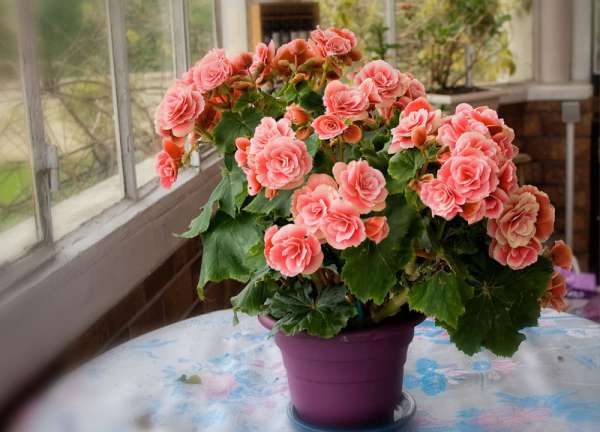

It is almost impossible to collect seeds from a ripe flower, so most often they can be purchased at the store, but the proposed varieties will be hybrid. Seed propagation is very troublesome and painstaking, it is rarely used.
For propagation of begonias in late spring or summer, stems are cut from an adult bush or dark cuttings of leaves are collected - this is the most common method of plant propagation. The immunity of the future flower needs to be strengthened, because it is affected by various bacteria, fungi and microorganisms. For this, the cuttings are fixed in sphagnum, vermiculite or perlite. You can put them in a container with water, after putting a few pieces of coal in it. Before planting in a pot, the cuttings should take root 6-7 cm long.
The pot is placed in a dark room, after one and a half to two months the flower will begin to germinate. Then it needs to be placed in a brightly lit room. As the bush develops, you need to pinch, forming its crown. And you also need to remove withered and dried flowers, leaves and cuttings.
Dormant period
The dormant period for the flower begins in the cold seasons of the year. It is important to know how to care for Elatior begonia during this time. The plant is placed in a room with a temperature regime of 18 to 20 degrees. Cool air will kill the begonias. You should not spray the leaves of the flower, and watering should be reduced three times compared to summer. To maintain a spectacular appearance, it is necessary to cut the stems, leaving cuttings up to 7 cm long.
In the beginning of March fertilize begonia with growth stimulants, applying them in turn according to the instructions. By following these simple rules, the plant will survive until summer days, and then begin to develop and bloom again.
Diseases and pests
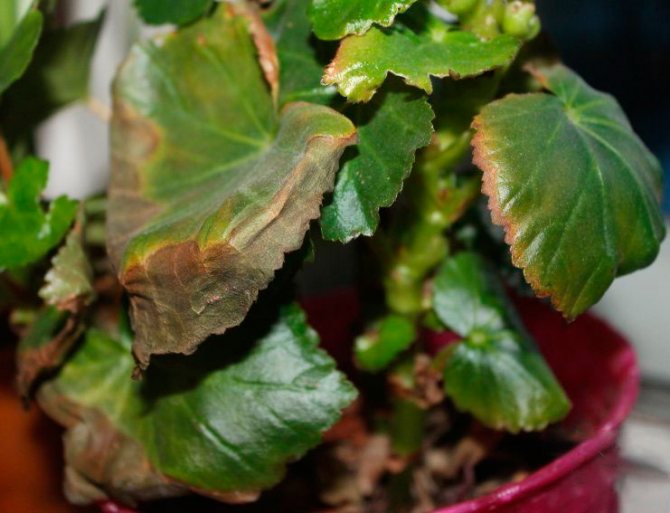

Diseases
Begonia elatior can get powdery mildew. In this case, very small specks of light color are formed on the surface of its foliage. There is a gradual darkening of the leaves and their drying. You can process the bush with a solution of tar soap (for 1 liter of water 20 grams) or copper sulfate (for 1 liter of water 2 grams). You can also use a solution of a fungicidal preparation.
If whitish spots with a slight grayish bloom appear on the bush, this means that it is affected by gray rot. The spots gradually darken and become brown and damp. Treat the diseased bush with a solution of Bordeaux liquid (1%) or any fungicidal preparation.
If the plant is affected by bacterial or ring spot, then it must be destroyed, and the pot must be thoroughly disinfected.
Pests
If a false shield settles on a begonia, it will begin to weaken and bloom poorly. At the same time, the foliage becomes faded and deformed. You can get rid of this pest by processing an infusion of garlic (the flower is sprayed once every 15 days).
To get rid of aphids, the flower is sprayed with a solution of tobacco infusion (two percent). Moreover, you need to withstand the infusion for two days.You can also use a 2–3% solution of laundry soap. You can also treat the bush with an insecticidal agent.
Soil and watering
Begonia has a weak root system that can only grow in loose soil. You can buy ready-made soil, or you can make it yourself. You will need peat, sand and greenhouse humus. It is necessary to provide drainage at the bottom of the pot so that water does not stagnate at the roots.
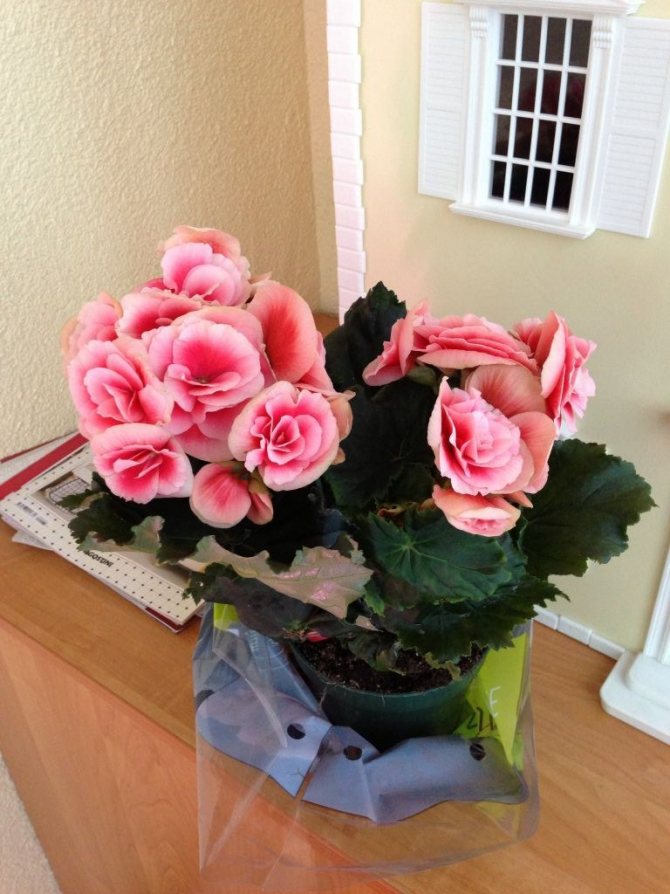

Watering should be moderate. Excess water will lead to rotting, and as a result, death. The water should be previously defended at room temperature. During the flowering period, watering is recommended more often, but only after the soil has dried out, from the previous watering.


Begonia Elatior
Begonia was presented to me by my husband on March 8th. I have a variety with orange flowers, it blooms for almost a whole year. Indeed, a very beautiful houseplant. I will not say that leaving requires special efforts. I put the pot on the north side of the window, I water it very rarely, sometimes I even forget. The only thing is that I constantly remove old leaves. So the flower is great.
I saw a begonia from a friend and immediately wanted the same flower for myself. She asked me to pinch off a piece of paper. I put it in a glass of water, and after about a month the roots appeared. I transplanted it into the ground and now I admire this beauty.
"Elatiorochka" - that's what I call my beauty. No hassle of maintenance. The main rule: do not fill it with water, even if it seems that it has not been watered for a long time. Her soil in the pot should be half dry. After the purchase, I transplanted it into a large pot.
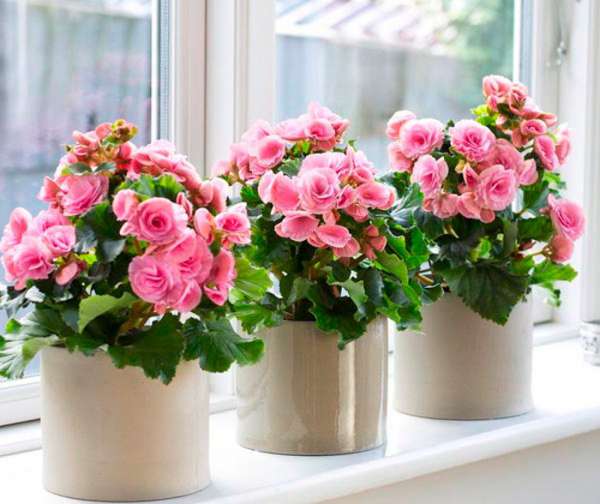

Begonia Elatior - This is the most popular type among florists and is often confused with tuberous. However, this type of this beautiful flower is hybrid, and it is obtained by crossing the tuberous and Socotran begonias.
This plant has an incredibly showy appearance. He has very bright beautiful flowers that stand out clearly against the background of green glossy leaves. It looks very impressive. Often such a blooming begonia is presented for a celebration, replacing it with a banal bouquet. Such a gift looks very impressive and not quite usual, and, as a rule, brings a lot of positive emotions to its new mistress.
Diseases, pests and problems in the cultivation of begonia Elatior
Under the right conditions and good care, Elatior begonias never get sick. They are much more resistant than all flowering begonias. In fact, they can only suffer from rot due to inaccurate watering and dampness.
When taken out into the garden or placed on balconies, Elatiors often suffer from powdery mildew. Fighting with fungicides on flowering begonias is useless, it is better to destroy the affected bushes as soon as possible. Occasionally, in the open air, plants are also threatened by aphids, which are best dealt with with insecticides.
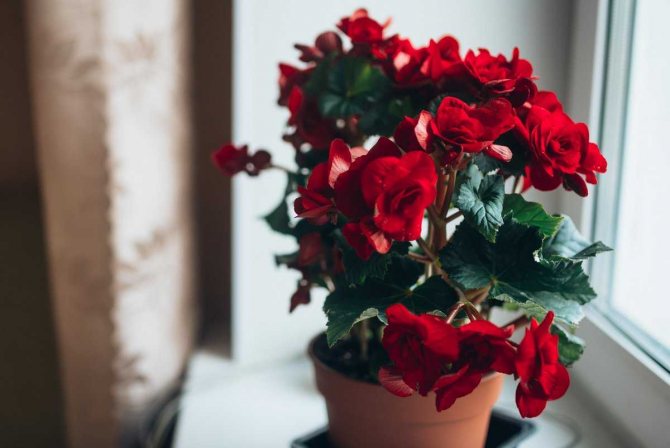

Under the right conditions and good care, Elatior begonias never get sick.
Formation
Care for begonia Elatior comes down not only to proper watering, top dressing and ensuring a certain level of humidity, temperature, but also to the formation of a bush. Pruning is carried out either in the fall or in the spring.
Regular formation allows you to get the same Elatior begonia bush as in the photo. The first procedure is carried out when the sprouts reach 7-9 cm. During the procedure, the plant is given any desired shape. The second time the plant is trimmed when it reaches a height of 13-15 cm. This time, unnecessary shoots are removed from above, on the sides.
In the process of growth, dry leaves and faded buds will appear on the bush, which must be removed so that they do not spoil the appearance. Prune the plant with a sharp knife.
When and how to replant after purchase
Florists do not recommend replanting the flower immediately after purchase. The plant should be allowed to acclimatize for at least a week and a half.
Important! If during the purchase of elatior begonia it is in the flowering stage, then the plant must be transplanted no earlier than it ends.
Since begonia has small roots, a small pot is also suitable for transplanting it after purchase. More important here is the composition of the soil, which should be loose, nutritious and have the ability to retain moisture.
Peat, humus and earthen mixtures in equal proportions, slightly diluted with river sand and perlite, are best suited for this. Then the young begonia must be transplanted annually, each time increasing the diameter of the new container by 5 cm, until the flower reaches 4 years of age, after which it is not recommended to disturb the plant any more.
Severe flower diseases
In addition, Begonia Elatior is also subject to various diseases.:
- Powdery mildew... It appears as white spots on the leaves that form a white bloom. As a result, the leaves dry up and fall off. For treatment, use foundationol (0.05-0.1%) or soap-vitriol liquid. To prepare it, take 2 g of copper sulfate and 20 g of soap per liter of water.
- Gray rot... Its appearance is provoked by the botrytis mushroom. Its presence betrays a white, watery coating on the tops of the Begonia, which then turns into wet brown rot. In this disease, the stem rots and breaks. An excellent method of treatment is a vitriol-soap solution. To prepare it, you will need 2 g of copper sulfate and 40 g of soap per liter of water.
- Bacterial spot... This disease is characterized by the appearance of watery spots on the leaves, after which the leaves and flowers deteriorate and turn black. In the fight against this disease, a suspension of copper oxychloride 0.5% is used. The treatment is repeated after 2 weeks.
- Ring spot... It appears as yellow-green spots. To cure a plant from such a disease, you need to destroy the pests that carry the virus.
Photo
Dangerous pests
The main pests of Begonia Elatior include:
- Soft false shield... It leaves a sugar coating on the plant, on which sooty mushrooms can appear as a result. In addition, this pest sucks juice from the leaves, which is why they lose color and deform. The damaged flower grows poorly and blooms little. To get rid of such a pest, you need to wipe the flower with a soft cloth dipped in infusions of garlic or pyrethrum.
- Greenhouse aphid... Its larvae suck juice from both leaves and flowers. As a result of the aphid invasion, Begonia's leaves turn yellow, and the flowers fall off. Also, this pest carries various viruses. To destroy the insect, use a soap or tobacco solution. To combat, use household or green soap, dissolve about 300 grams in 10 liters of water. To prepare a tobacco solution, you need to soak 100 g in a liter of warm water. Insist on this mixture for 2 days, and then strain and add 2 times more water.
- Greenhouse whitefly... It is mainly found in greenhouses, but in summer you can also see it outdoors. Harms the leaves of the plant, as a result of which they lose color. It also carries various viruses. Soap spraying is used against it with the calculation of about 40 g of soap per 10 liters of water.
- Greenhouse thrips... As a result of his activity, flowers are disfigured, leaves turn yellow and growth is greatly slowed down. He dies due to the use of soapy water, a decoction of tobacco or celandine, 100 g of which is used per liter of water.
- Gall nematode... It is a very small worm that takes up residence in the root system and the lower part of the stem. It attacks the root system, as a result of which growth slows down, the roots rot and the flower dies. To get rid of such a parasite, the roots are eliminated, and the soil is watered with a 1% formalin solution.
- Leaf nematode... A worm that destroys the buds and provokes the appearance of brown spots on the leaves.The top of the flower becomes especially terrible, which, as a rule, is bent. The affected flower often dies. The diseased plant is destroyed. But if it is not yet strongly affected, then you can try to cure it with a solution of heterophos (0.05-2%).
How to propagate and transplant a flower at home
In order for the plant to bloom and grow profusely, it is necessary to be able to transplant it correctly, select a pot and propagate it.
Pot selection
First of all, you need to pay attention to the size of the pot. So, for young seedlings, it should be 8-10 cm in height, and for each further transplant, its size should increase by a third of the previous one. So the container will not be too spacious, which can lead to rotting of the root system. Also, there must be several drainage holes in the pot. The shape of the pot can be any.
Advice!
Experts recommend giving preference only to ceramic pots, as they are considered the safest.
Transfer
First of all, you need to prepare a new pot for transplanting. The container must be thoroughly washed in hot water. Ceramic are treated with boiling water and soaked in water for a day. At the bottom of the container, a layer of charcoal is initially laid out, on top of which a drainage layer of several centimeters is laid out.
Begonia must be watered abundantly and left for an hour. After that, the flower must be carefully removed from the pot and carefully examined for damage. The damaged parts are cut off, and the root system can be treated with potassium permanganate in order to prevent the growth of microorganisms.
The plant is placed in a new pot and covered with substrate. The top layer must be fluffed in order to increase air permeability. The neck of the plant should not be underground.
Reproduction
Begonia is propagated by cuttings of leaves or stems. To do this, cut off 10-12 cm of the stem or simply tear off a leaf.
A young plant is rooted in water, to which a few tablets of activated carbon are added to prevent microbial contamination. The shoot is kept in the same conditions as a mature flower. A rooted young plant is planted in a pot up to 10 cm high.
How and when to pinch a flower
Pinch the flower in the spring and autumn. Begonia Elatior grows very quickly, because in order for it to retain its beautiful decorative appearance, it is necessary to prune it... The first time this is done, when the plant reaches 7 cm, it is given any shape, depending on the taste of the owner.
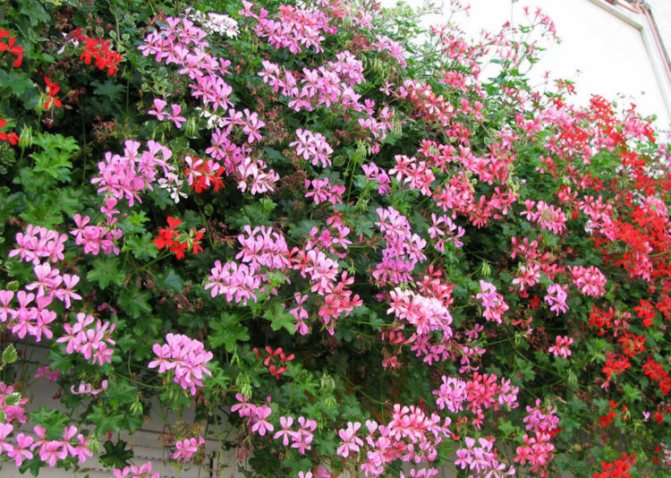

From the very beginning of the growth of the Elatior begonia seedling, you need to do it by pinching it
After that, watering is reduced, until the moment when the flower begins to grow intensively. When its shoots again reach a length of 12 cm, then the Begonia is again cut from the top and sides. As a result, lateral buds may appear, which must be monitored and not allowed to grow inward.
If all these moments were missed, and the plant did not grow beautiful, then you need to cut off the lower shoots and the top. In the case when this method did not help, the plant needs to be re-rooted.
Features of feeding
With the onset of spring, the flower must be fed. At the very beginning of growth activation, mineral fertilizers with a high nitrogen content are applied to stimulate the growth of green mass. During the flowering period, fertilizers with phosphorus and potassium are used.
Lack of nutrition can negatively affect the appearance of the plant. His tips begin to turn yellow, growth slows down, inflorescences become smaller.


Tips for choosing a plant in the store
In order for a flower to please the eye for a long time, it is necessary to initially acquire a healthy plant. In the store, you should pay attention initially to the leaves. They will have an even green tint without blotches and dry ends. There should be no cobwebs and pests on the back of the leaf and stems.
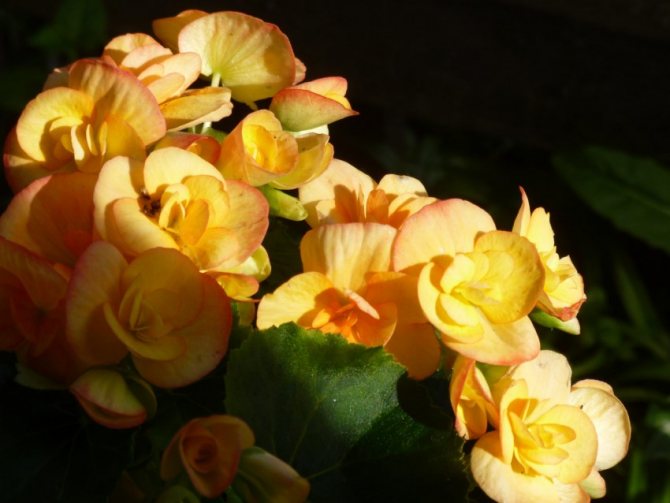

It will be better if begonia blooms initially.So, according to personal preferences, you can choose the color of the flowers. When buying in cold weather, you do not need to immediately get rid of the protective packaging at home. It is worth waiting for the temperature to equalize.
Transplant, containers and substrate
Begonias of the Elatior group are transplanted immediately after flowering. Plants are carefully transferred to a fresh substrate, removing damaged roots if there are signs of decay. The timing of the transplant depends on when the plant has bloomed. If the transplant is postponed until spring, then it is carried out from April.
Containers for elatiors should be compact. Plants are grown in classic, slightly tall, upward expanding pots with a diameter from "starting" 10 cm to 14 cm for large bushes. Increase the containers by 1-2 cm.
Experimenting with Elatior begonias substrate is not worth it. They can bloom luxuriantly only in a high-quality substrate with controlled characteristics. For begonias of this group, only special substrates for begonias are used - and it is advisable to look for soils for flowering flowers, and not universal begonia species of soil mixtures.
If the soil mixture is compiled independently, it is worth choosing a complex combination of leafy soil with peat and sand with small additions of sod and humus soil (12: 10: 4: 1: 2) with a pH value of 6 to 6.5 or a mixture of different types of peat with inert additives. Peat is a must in the soil.
When transplanting Elatior begonias, it is impossible to deepen the root collars and tamp the soil around the plants, leaving it loose and filling as it shrinks. An accurate transplant without unnecessary contacts is the best option. After transplanting, light watering is carried out.
Care Reviews
According to reviews, begonia elatior is a capricious plant. She is demanding on growing conditions. Reacts negatively to any changes. Also, the plant does not tolerate stressful situations. Therefore, the rules for caring for this hybrid need to be considered in detail. Errors in this process cannot be allowed.


The efforts of the grower are rewarded with interest when begonia begins to bloom. This sight cannot be described in words. Some varieties resemble a real bouquet in a pot. Many growers claim that begonias can be given for celebrations instead of the usual bouquet of cut flowers. Such a gift evokes a lot of positive emotions. At the same time, begonia will be able to bloom for a long time, delighting its owners.
Almost all varieties are demanding on lighting and room temperature. They need to be properly looked after, providing the plants with everything they need. The transplant process requires special attention. The plant does not like such interventions. Therefore, it is important to do all the actions correctly.
The soil
Home begonia elatior grows in special soil. It can be purchased from a specialist store. This soil is intended exclusively for begonias. The soil must be loose. For this, it must include vermiculite. Perlite is also often used for this.
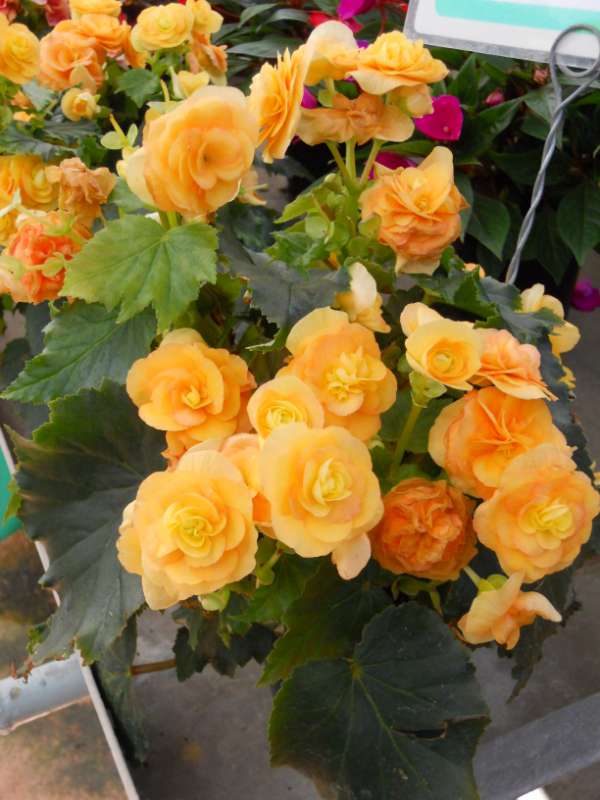

The air permeability of the soil is the key to the comfortable growth of begonia. You can prepare the planting mixture yourself. To do this, mix leaf, peat soil and humus in one part. Next, half of the sand is added to the composition.
It is important to regularly add groundbait to the soil. The mineral type of fertilizers is best suited for these purposes. They are used for flowering ornamental plants. Fertilizers need to be applied once a week. The amount of fertilizers should be reduced by 2 times compared to the dosage indicated on the package.
Temperature control and ventilation
Any flowering begonias should be protected from heat. But Elatior begonias will prefer very stable and moderate temperatures within the range of 16 to 21 degrees Celsius, even in summer. Any excess of 22 degrees will shorten the flowering period and require air humidity control.
Heat leads to a loss of terry and stretching of the plant, especially if temperatures exceed 28 degrees in the fresh air. At the same time, during the budding period, the temperature is critical: the better the indicators stabilize at a value of 20 degrees or slightly higher, the more luxuriant the begonias will bloom.
If it is possible to control the temperatures stricter, you can use the secret for the longest possible flowering of the Elatior begonia: increase the temperatures by at least 3-4 degrees at the budding stage and lower them to coolness at the flowering stage.
The minimum temperatures that elatiors can endure are about 12 degrees. But the cold will not pass without a trace. Plants will prefer to spend even the dormant period at a temperature of 16 to 18 degrees. If the plants continue to bloom in winter, then such a decrease is unacceptable.
For almost all new varieties of Elatior begonias, it is preferable to keep them even at the height of winter at a temperature of at least 20 degrees. The minimum indicators at which flowering continues is 18 degrees Celsius. At the same time, any fluctuations in temperature have an extremely negative effect on flowering.
These plants need to be protected from any sudden changes in temperature, especially cold snaps and drafts. The more stable the environment, the more abundant and longer the elatiors will bloom. Even from a period of active development to a dormant period and back, plants should be transferred gradually, with intermediate transitions.
Elatior hybrid begonias love fresh air. Frequent airing to protect the plant from drafts is a prerequisite for plant health. Drafts, especially cold ones, cause the begonias of the Elatior group to shed their buds.
All elatiors bloom successfully in the fresh air. Plants can be taken out on balconies and in the garden, placed in sheltered places and in partial shade, not in too bright sun. But you should be prepared for the fact that after returning to the rooms, in the absence of a soft transfer to new conditions, flowering in the rooms may not continue.
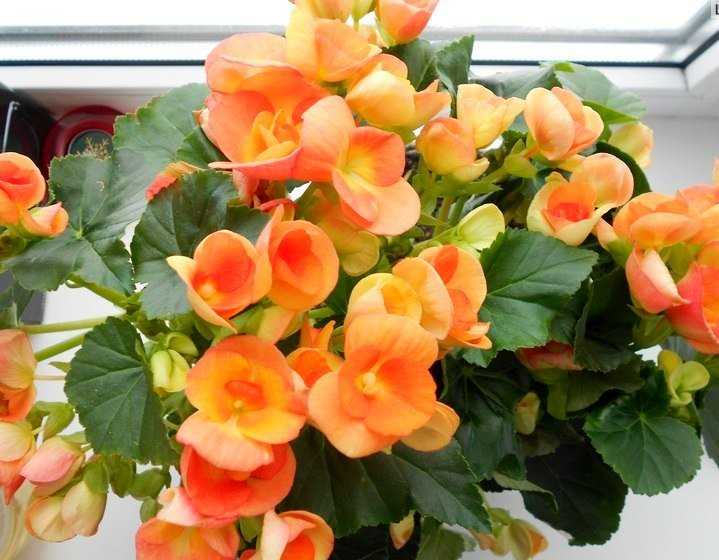

Begonia Elatior ‘Eva’.
Lighting
Indoor begonia Elatior needs careful maintenance. The choice of the location of the pot with the plant must be approached responsibly. Sunlight is essential because in the shade, the flowers become small and gradually flowering fades away.
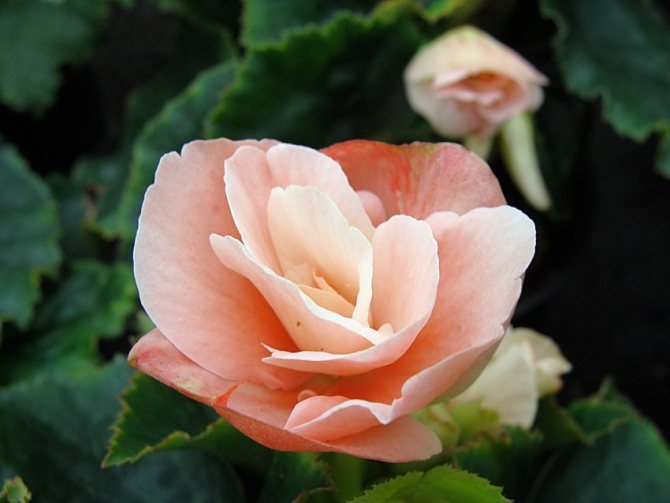

Direct rays can injure leaves and damage the plant. The best option is diffused sunlight. To achieve this, a white sheet of paper must be attached to the window.
Florist reviews


Unlike other types of begonia, elatior is quite unpretentious. But still, low humidity in the room and a draft can greatly harm her. It was noticed by flower growers that even in the second and subsequent years of life, the growth of the bush does not stop, which is an undoubted advantage of this species. But in order for the bush to always look neat, you need to cut out the old foliage and shoots in time. In winter, it is extremely difficult to create optimal conditions for a flower, and rusting of the leaves is often noted. However, this begonia is perfect for both the garden and the home.
Bloom
In order for elatior to bloom for a long time and profusely, create an artificial "short day" - the duration of daylight hours is reduced to 9 o'clockcovering the plant black plastic wrap.
Such a procedure, carried out during two weeks, promotes the formation of buds.
So that during this time the stems do not stretch out, use growth retardants or pinch the shoots.
Then daylight again increase to 16 hours - additional lighting may be needed.
As a result begonia blooms in about 2 months.
Withered inflorescences, like dried leaves, should be removed in a timely manner.
It should also be noted that a plant that once bloomed "in full" - for a long time, abundantly and for a long time - recovers for a long time and is unlikely to bloom again with the same intensity.
The appearance and features of the plant
Elatior begonia variety is hybrid, was bred at the end of the 19th century in England. Its progenitors were the Socotransky and tuberous begonia varieties. In the future, this made it possible to obtain hybrids with non-trivial flowering and excellent decorative properties.
During this period, Holland is considered a mass producer of Elatior plants. There, flowers are bred in greenhouse and indoor conditions, getting all new species that are more resistant to fungal diseases. Dutch begonias are transported to European countries, Russia, America. Plants are used for landscaping landscaping designs.
The winter begonia hybrid is an annual shrub with densely flowering inflorescences. The maximum flower height reaches 40 cm.
The plant has a dense, developed stem, as well as asymmetric heart-shaped foliage. Above, the leaves have a rich green color, the lower part is a light green hue. The size of the flowers is up to 8 cm in diameter.
Varieties
In addition to this classification, there are several more varieties of elatior begonia, most often cultivated at home:
- grade Baladin, which, thanks to the multi-height peduncles, creates the appearance of a multi-tiered bouquet, from a distance resembling a bouquet of roses planted in a pot;


- English variety Borias, characterized by large coral and pink flowers, resembles roses even more, but blooms longer and more magnificently;


- a native of Southeast Asia - grade Grace, growing no higher than 35 cm, is covered with a powerful head of red flowers that bloom repeatedly throughout the year and do not fade for 2-3 months.



